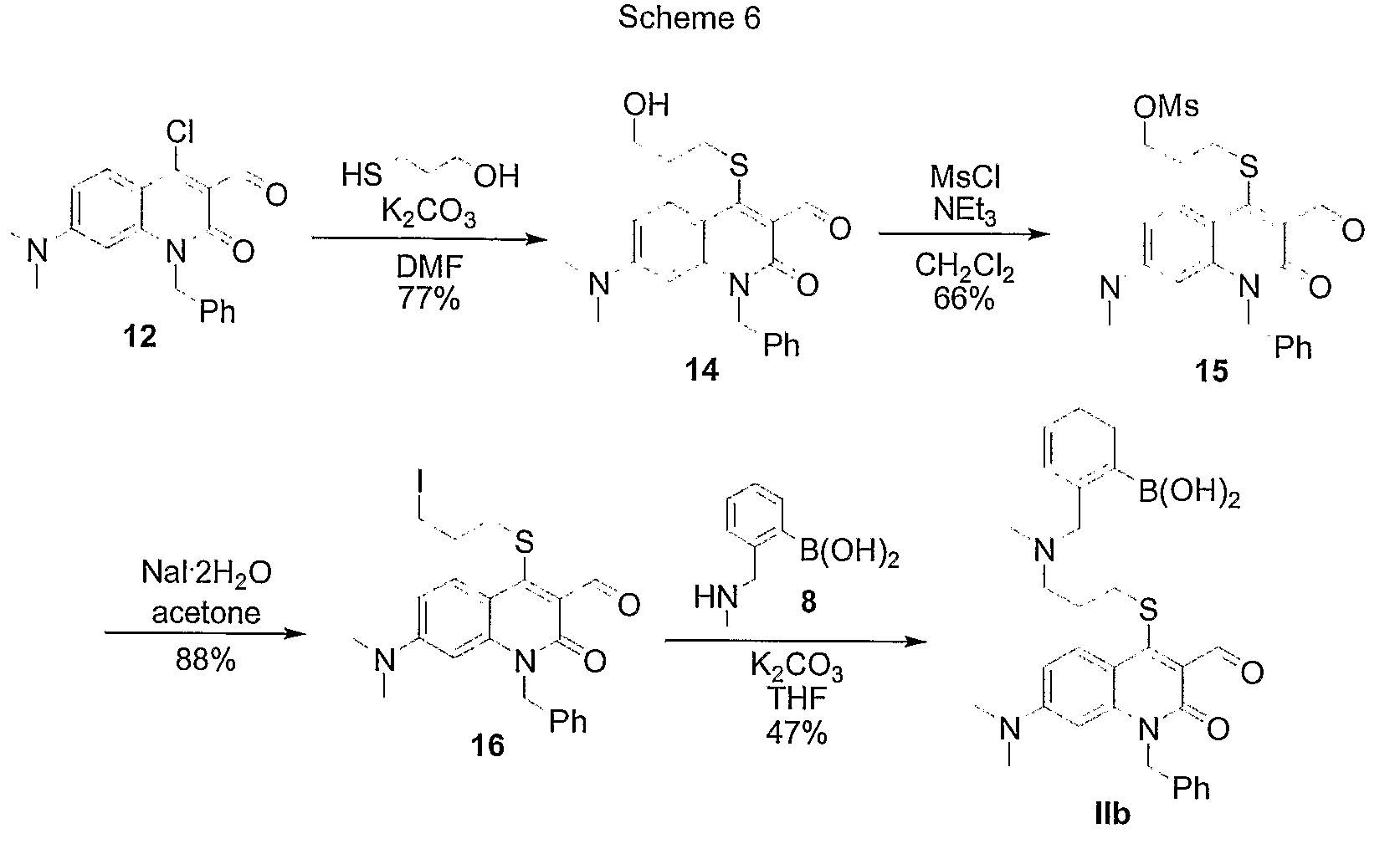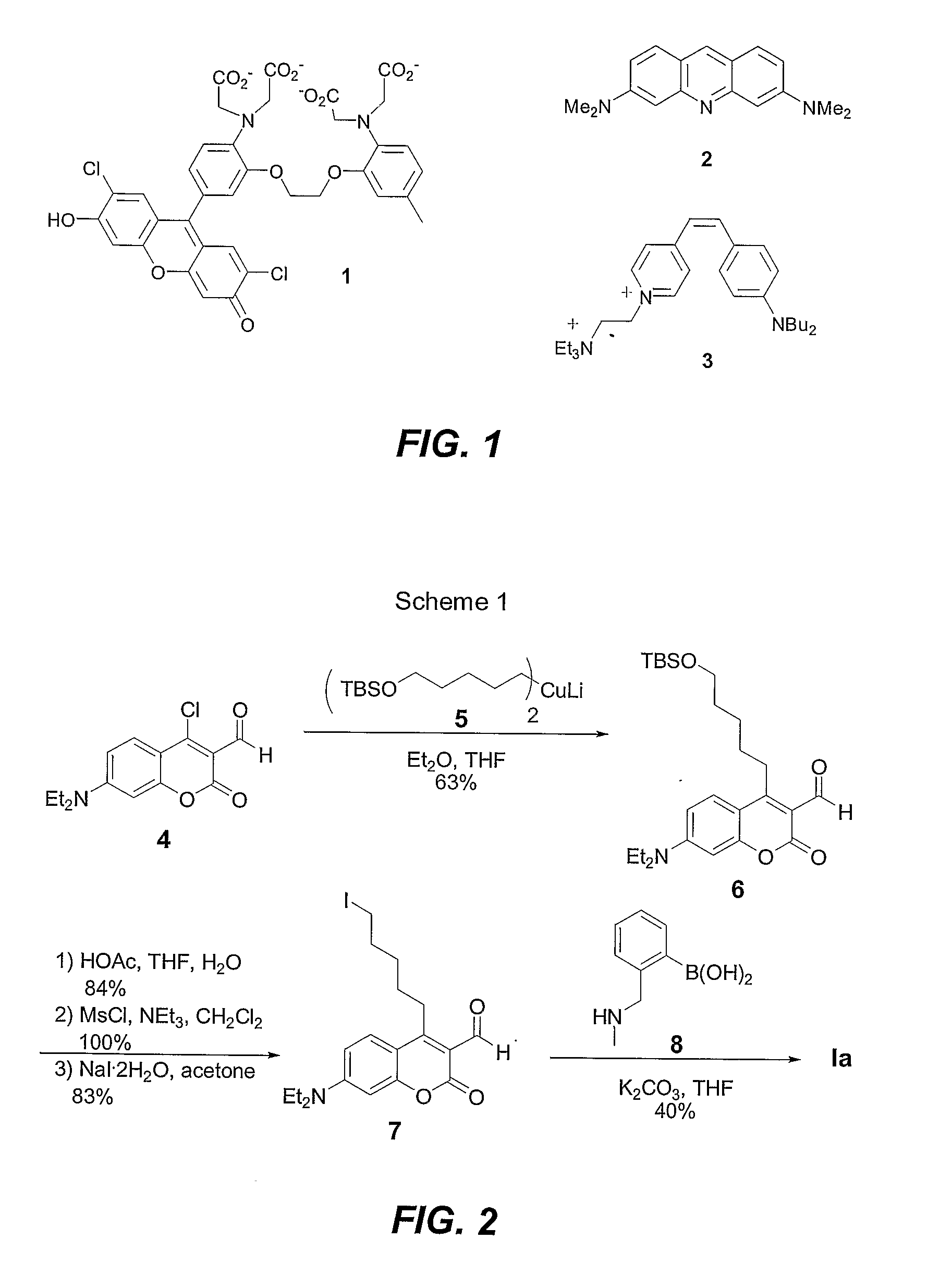Fluorescent Sensors for Cellular Amines
- Summary
- Abstract
- Description
- Claims
- Application Information
AI Technical Summary
Benefits of technology
Problems solved by technology
Method used
Image
Examples
example 1
Synthesis of Coumarin Boronic Acid Sensor (Sensor Ia)
[0117](1) Synthesis of TBSO-pentyl coumarin (compound 6 in Scheme 1). A solution of TBS-protected 5-iodopentanol (2.35 g, 7.15 mmol) and Et2O (70 mL) in a flame-dried, N2-flushed flask was cooled to −78° C. tBuLi (10.0 mL, 1.5 M, 15.0 mmol) was added, and the mixture was stirred at −78° C. for 5 min. then ambient temeratue for 1 h. The solution was cooled to 0° C., and CuI (681 mg, 3.58 mmol) was added. The mixture was stirred at 0° C. for 10 min; the mixture turned dark purple during this time. The reaction mixture was cooled to −78° C., and THF (35 mL) was added. Coumarin chloroaldehyde 4 (1.00 g, 3.58 mmol) in THF (35 mL) was added via cannula. The reaction was stirred under N2 at −78° C. for 30 min. then quenched with saturated NH4Cl (75 mL). The mixture was extracted with CH2Cl2 (3×150 mL). The combined organic layers were dried over MgSO4, and the solvent was removed in vacuo. The resulting yellow solid was purified via flas...
example 2
Synthesis of Thioethyl Quinolone (Sensor IIa)
[0132](1) Synthesis of 4-Hydroxy Quinolone (compound 11 in Schemes 2 and 3). N1,N1-dimethyl-N3-benzylaniline (4.39 g, 19.4 mmol), bis(2,4,6-trichlorophenyl)malonate (8.98 g, 19.4 mmol), and toluene (150 mL) were added to a flame-dried flask. A reflux condenser and drying tube were attached, and the mixture was refluxed for 20 h. The reaction mixture was cooled and filtered. The filtrate was washed with hexanes to yield the title compound as tan a powder (5.8 g, 100%).
[0133]Data for 4-Hydroxy Quinolone: mp=284°-286°, decomp.; 1H NMR (250 MHz, DMSO-d6): δ11.0 (1H, s), 7.65 (1H, d, J 9.0), 7.19-7.28 (5H, m), 6.59 (1H, dd, J2.0 and 9.0), 6.29 (1H, d, J 1.9), 5.69 (1H, s), 5.40 (2H, s) and 2.86 (6H, s); 13C NMR (62.5 MHz, DMSO-d6): δ 163.5, 161.9, 152.0, 140.8, 137.9, 128.4, 126.8, 126.7, 124.1, 107.1, 105.9, 96.2, 93.4, 43.9, 39.6; FTIR (neat): 1625, 1569, 1544, 1537, 1488, 1384, 1354.
[0134]HRMS Calc. for C18H18LiN2O2(M+Li)+: 301.1528. Found:...
example 3
Synthesis of S-linked Quinolone Boronic Acid Sensor IIb
[0141]Sensor IIb is synthesis according to the Scheme 6 in FIG. 12.
[0142](1) Synthesis of S-linked Quinolone Alcohol (compound 14 in Scheme 6). Quinolone chloroaldehyde (1.00 g, 2.94 mmol), K2CO3 (2.0 g, 14.7 mmol), and DMF (30 mL) were combined in a flame-dried, N2-filled flask. 3-mercaptopropanol (380 μL, 4.40 mmol) was added, and the mixture was stirred at ambient temperature under N2 for 17 hours. The reaction mixture was then poured onto H2O (150 mL) and extracted with CH2Cl2 (3×100 mL). The combined organic extracts were washed with brine (100 mL) then dried on MgSO4. The solvent was removed in vacuo, and the resulting yellow solid was purified via flash chromatography (EtOAc then EtOAc / CH2Cl2, 50:50). The product was isolated as a yellow solid (892.5 mg, 77%).
[0143]Data for S-linked Quinolone Alcohol: mp=182.5-183° C.; 1H NMR (500 MHz, CDCl3): δ 10.60 (s, 1H), 8.40 (d, J=9.3 Hz, 1H), 7.24-7.33 (m, 5H), 6.64 (dd, J=2.4 Hz,...
PUM
 Login to View More
Login to View More Abstract
Description
Claims
Application Information
 Login to View More
Login to View More - R&D Engineer
- R&D Manager
- IP Professional
- Industry Leading Data Capabilities
- Powerful AI technology
- Patent DNA Extraction
Browse by: Latest US Patents, China's latest patents, Technical Efficacy Thesaurus, Application Domain, Technology Topic, Popular Technical Reports.
© 2024 PatSnap. All rights reserved.Legal|Privacy policy|Modern Slavery Act Transparency Statement|Sitemap|About US| Contact US: help@patsnap.com










